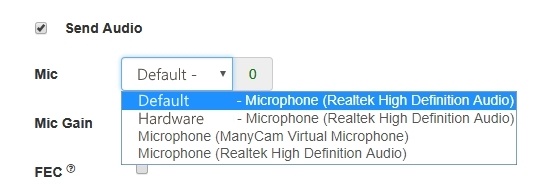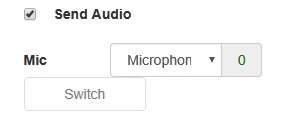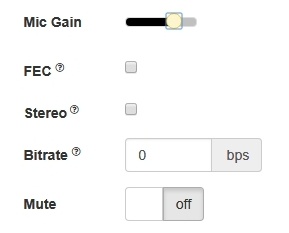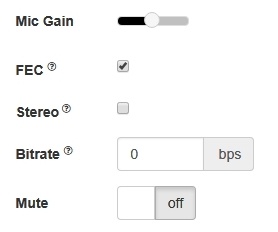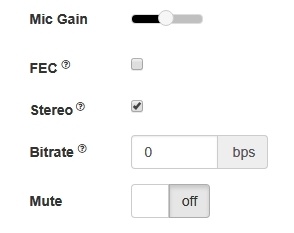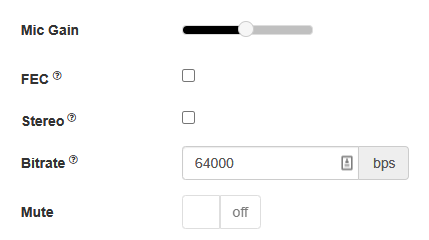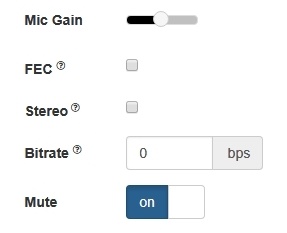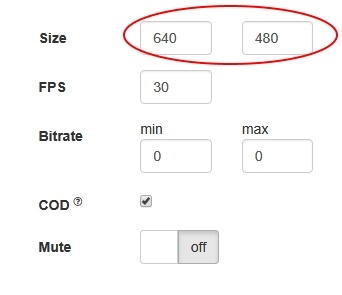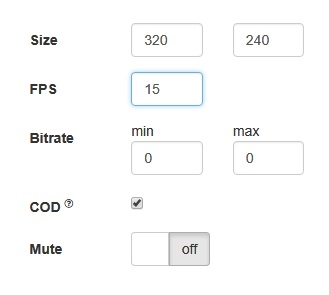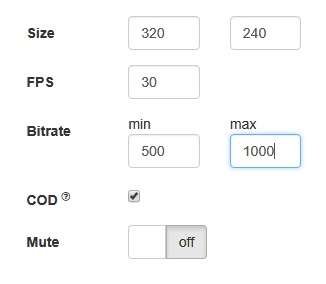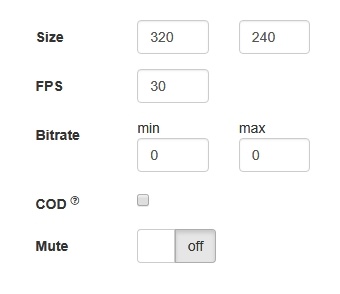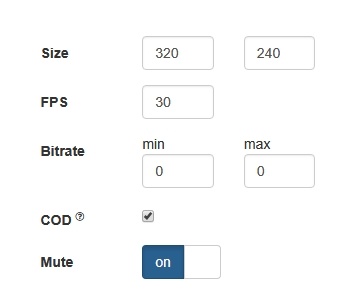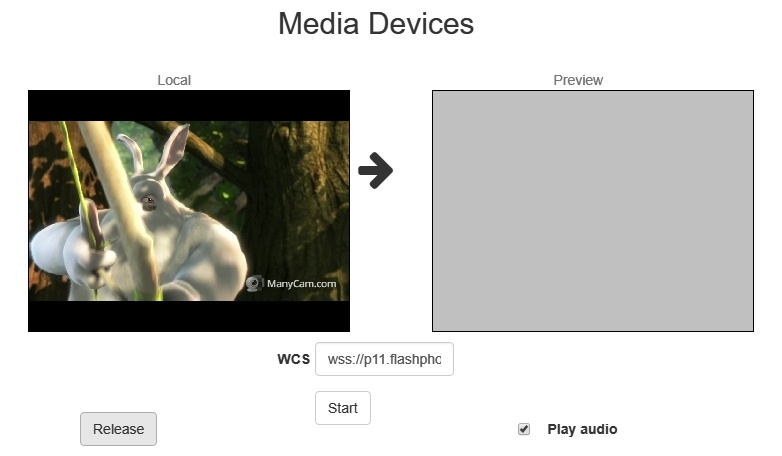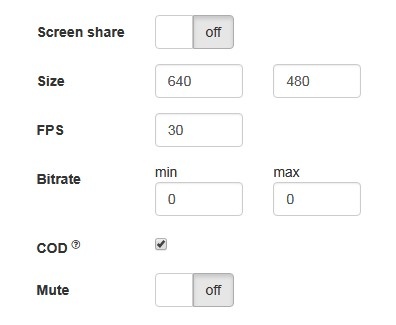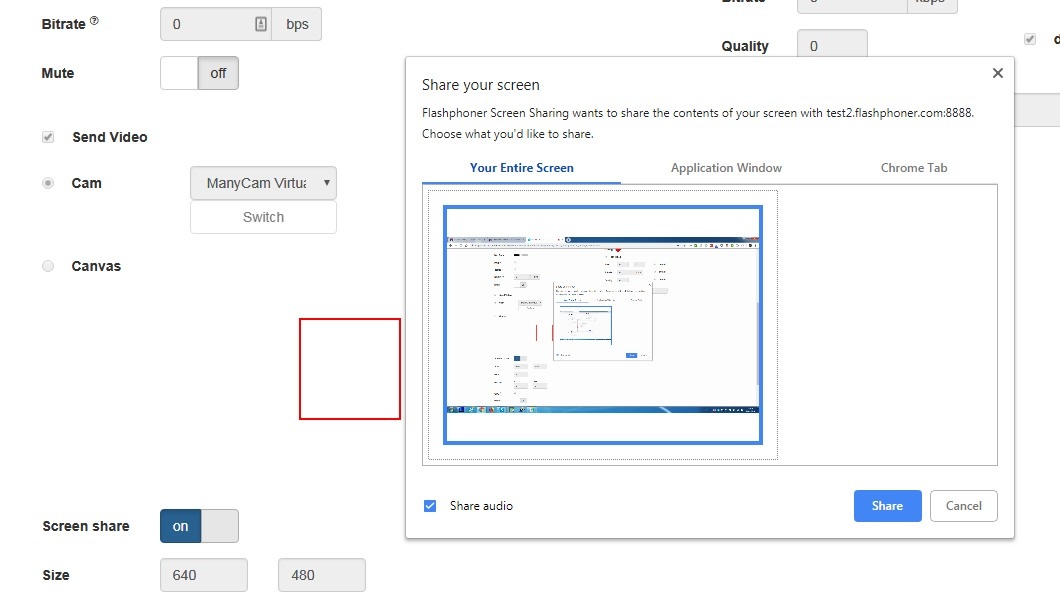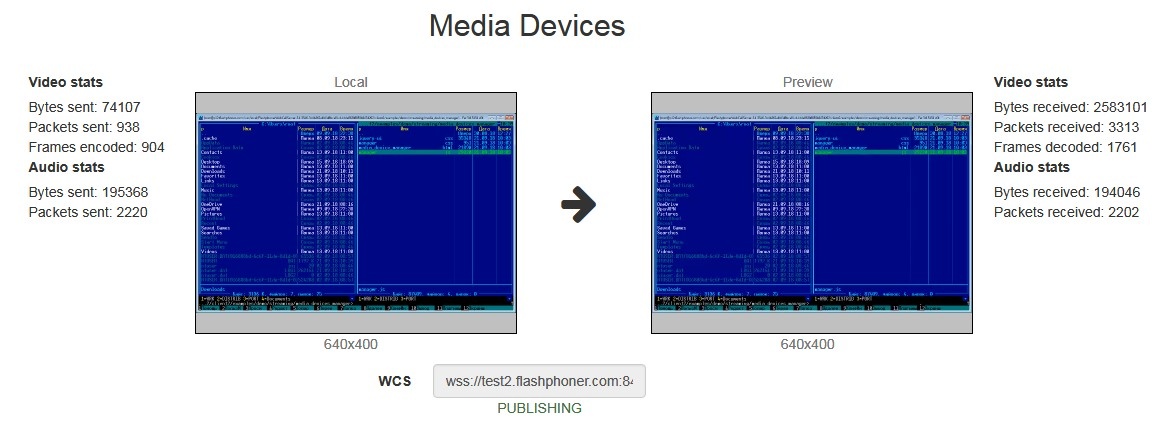WCS allows configuring the camera and the microphone from a browser. Let's see how this can be done and what parameters you can adjust when an audio and video stream is captured. We use the Media Devices web application as an example:
Microphone settings
1. Selecting the microphone from the list
code:
Flashphoner.getMediaDevices(null, true, MEDIA_DEVICE_KIND.INPUT).then(function (list) {
list.audio.forEach(function (device) {
...
});
...
}).catch(function (error) {
$("#notifyFlash").text("Failed to get media devices");
});
2. Microphone switching while stream is publishing
code:
$("#switchMicBtn").click(function (){
stream.switchMic().then(function(id) {
$('#audioInput option:selected').prop('selected', false);
$("#audioInput option[value='"+ id +"']").prop('selected', true);
}).catch(function(e) {
console.log("Error " + e);
});
}).prop('disabled', !($('#sendAudio').is(':checked')));
3. Adjusting microphone gain (works in Chrome only)
code:
$("#micGainControl").slider({
range: "min",
min: 0,
max: 100,
value: currentGainValue,
step: 10,
animate: true,
slide: function (event, ui) {
currentGainValue = ui.value;
if(previewStream) {
publishStream.setMicrophoneGain(currentGainValue);
}
}
});
4. Enabling error correction (for the Opus codec only)
code:
if (constraints.audio) {
constraints.audio = {
deviceId: $('#audioInput').val()
};
if ($("#fec").is(':checked'))
constraints.audio.fec = $("#fec").is(':checked');
...
}
5. Setting stereo/mono mode.
code:
if (constraints.audio) {
constraints.audio = {
deviceId: $('#audioInput').val()
};
...
if ($("#sendStereoAudio").is(':checked'))
constraints.audio.stereo = $("#sendStereoAudio").is(':checked');
...
}
6. Setting audio bitrate in bps
code:
if (constraints.audio) {
constraints.audio = {
deviceId: $('#audioInput').val()
};
...
if (parseInt($('#sendAudioBitrate').val()) > 0)
constraints.audio.bitrate = parseInt($('#sendAudioBitrate').val());
}
7. Turning off the microphone (mute).
code:
if ($("#muteAudioToggle").is(":checked")) {
muteAudio();
}
Camera settings
1. Camera selection
code:
Flashphoner.getMediaDevices(null, true, MEDIA_DEVICE_KIND.INPUT).then(function (list) {
...
list.video.forEach(function (device) {
...
});
}).catch(function (error) {
$("#notifyFlash").text("Failed to get media devices");
});
If audio devices access should not be requested while choosing a camera, getMediaDevices() function should be called with explicit constraints setting
Flashphoner.getMediaDevices(null, true, MEDIA_DEVICE_KIND.INPUT, {video: true, audio: false}).then(function (list) {
...
list.video.forEach(function (device) {
...
});
}).catch(function (error) {
$("#notifyFlash").text("Failed to get media devices");
});
2. Switching cameras while stream is publishing
code:
$("#switchBtn").text("Switch").off('click').click(function () {
stream.switchCam().then(function(id) {
$('#videoInput option:selected').prop('selected', false);
$("#videoInput option[value='"+ id +"']").prop('selected', true);
}).catch(function(e) {
console.log("Error " + e);
});
});
Switching of the camera can be done "on the fly" during stream broadcasting. Here is how switching works:
- On PC cameras switch in the order they are defined in the device manager of the operating system.
- On Android, if Chrome is used, the default is the frontal camera. If Firefox is used, the default is the rear camera.
- On iOS in the Safari browser, by default the frontal camera is selected, but in the drop-down the rear camera is the first.
3. Specifying the resolution of the video
code:
constraints.video = {
deviceId: $('#videoInput').val(),
width: parseInt($('#sendWidth').val()),
height: parseInt($('#sendHeight').val())
};
if (Browser.isSafariWebRTC() && Browser.isiOS() && Flashphoner.getMediaProviders()[0] === "WebRTC") {
constraints.video.deviceId = {exact: $('#videoInput').val()};
}
4. Setting FPS
code:
if (constraints.video) {
...
if (parseInt($('#fps').val()) > 0)
constraints.video.frameRate = parseInt($('#fps').val());
}
5.Setting video bitrate in kbps
code:
if (constraints.video) {
...
if (parseInt($('#sendVideoMinBitrate').val()) > 0)
constraints.video.minBitrate = parseInt($('#sendVideoMinBitrate').val());
if (parseInt($('#sendVideoMaxBitrate').val()) > 0)
constraints.video.maxBitrate = parseInt($('#sendVideoMaxBitrate').val());
...
}
6. Setting CPU Overuse Detection
code:
if (!$("#cpuOveruseDetection").is(':checked')) {
mediaConnectionConstraints = {
"mandatory": {
googCpuOveruseDetection: false
}
}
}
7. Turning off the camera (mute)
code:
if ($("#muteVideoToggle").is(":checked")) {
muteVideo();
}
Testing camera and microhpone capturing locally
Local camera and microphone test is intended to check capturing in browser without publishing stream to server.
code:
function startTest() {
Flashphoner.getMediaAccess(getConstraints(), localVideo).then(function (disp) {
$("#testBtn").text("Release").off('click').click(function () {
$(this).prop('disabled', true);
stopTest();
}).prop('disabled', false);
window.AudioContext = window.AudioContext || window.webkitAudioContext;
if (Flashphoner.getMediaProviders()[0] == "WebRTC" && window.AudioContext) {
for (i = 0; i < localVideo.children.length; i++) {
if (localVideo.children[i] && localVideo.children[i].id.indexOf("-LOCAL_CACHED_VIDEO") != -1) {
var stream = localVideo.children[i].srcObject;
audioContextForTest = new AudioContext();
var microphone = audioContextForTest.createMediaStreamSource(stream);
var javascriptNode = audioContextForTest.createScriptProcessor(1024, 1, 1);
microphone.connect(javascriptNode);
javascriptNode.connect(audioContextForTest.destination);
javascriptNode.onaudioprocess = function (event) {
var inpt_L = event.inputBuffer.getChannelData(0);
var sum_L = 0.0;
for (var i = 0; i < inpt_L.length; ++i) {
sum_L += inpt_L[i] * inpt_L[i];
}
$("#micLevel").text(Math.floor(Math.sqrt(sum_L / inpt_L.length) * 100));
}
}
}
} else if (Flashphoner.getMediaProviders()[0] == "Flash") {
micLevelInterval = setInterval(function () {
$("#micLevel").text(disp.children[0].getMicrophoneLevel());
}, 500);
}
testStarted = true;
}).catch(function (error) {
$("#testBtn").prop('disabled', false);
testStarted = false;
});
}
SDP parameters replacing
When publishing stream, there is a possibility to replace SDP parameters. In 'SDP replace' field string template is set for search for the parameter to replace, and in 'with' field new parameter value is set.
To replace SDP parameters, a callback function is used that should be set on stream creation in sdpHook option of createStream() method:
stream creation code
publishStream = session.createStream({
name: streamName,
display: localVideo,
cacheLocalResources: true,
constraints: constraints,
mediaConnectionConstraints: mediaConnectionConstraints,
sdpHook: rewriteSdp,
...
})
rewriteSdp function code
function rewriteSdp(sdp) {
var sdpStringFind = $("#sdpStringFind").val().replace('\\r\\n','\r\n');
var sdpStringReplace = $("#sdpStringReplace").val().replace('\\r\\n','\r\n');
if (sdpStringFind != 0 && sdpStringReplace != 0) {
var newSDP = sdp.sdpString.toString();
newSDP = newSDP.replace(new RegExp(sdpStringFind,"g"), sdpStringReplace);
return newSDP;
}
return sdp.sdpString;
}
Rising up the bitrate of video stream published in Chrome browser
SDP parameters replacement allows to rise video streeam published bitrate. To do this, SDP parameter 'a' must be replaced by this template when publishing H264 stream:
a=fmtp:(.*) (.*)
to
a=fmtp:$1 $2;x-google-min-bitrate=2500
where 2500 is the bitrate in kilobytes per second.
Similarly, video bitrate on start can be set (x-google-start-bitrate attribute) and maximum bitrate can be limited (x-google-max-bitrate attribute). Note that if minimum bitrate only is set, then resulting bitrate cannot be above 2500 kbps, probably maximum bitrate value is fixed on this level by default in Chrome browser. When higher bitrate values are required, for example, to publish high reso;ution streams, both minimum and maximum values must be explicitly set:
a=fmtp:$1 $2;x-google-max-bitrate=7000;x-google-min-bitrate=3000
In this case browser will try to keep bitrate in limits from 3000 to 7000 kbps when publishing a stream.
When publishing VP8 stream, SDP parameter 'a' must be replaced by this template
a=rtpmap:(.*) VP8/90000\r\n
to
a=rtpmap:$1 VP8/90000\r\na=fmtp:$1 x-google-min-bitrate=3000;x-google-max-bitrate=7000\r\n
This feature is available in Chrome browser only.
Bandwidth management
SDP parameters replacement allows to set bandwidth for stream publishhed. To do this, SDP parameter 'c' must be replaced by this template when publishing stream
c=IN (.*)\r\n
to
c=IN $1\r\nb=AS:10000\r\n
Setting up codecs
When publishing the stream, there is a possibility to eliminate from WebRTC SDP codecs that should not be used to publish the given stream, for example:
publishStream = session.createStream({
...
stripCodecs: "h264,H264,flv,mpv"]
}).on(STREAM_STATUS.PUBLISHING, function (publishStream) {
...
});
publishStream.publish();
Such a capability is handy when you need to find some workaround for bugs of a browser or if it conflicts with the given codec. For example, if H.264 does not work in a browser, you can turn it off and switch to VP8 when working via WebRTC.
Sound device selection
Sound output device can be selected (and switched "on the fly") while stream is playing in Chrome and MS Edge browsers.
code:
Flashphoner.getMediaDevices(null, true, MEDIA_DEVICE_KIND.OUTPUT).then(function (list) {
list.audio.forEach(function (device) {
...
});
}).catch(function (error) {
$('#audioOutputForm').remove();
});
Note that Firefox and Safari browsers always return empty output devices list, therefore sound device setection does not supported for these browsers
WebRTC statistics displaying
A client application can get WebRTC statistics according to the standard while publishing or playing stream. The statistics can be displayed in browser, for example:
Note that in Safari browser audio only statistics can be displayed.
1. Statistics displaying while stream is published
stream.getStats() code:
publishStream.getStats(function (stats) {
if (stats && stats.outboundStream) {
if (stats.outboundStream.video) {
showStat(stats.outboundStream.video, "outVideoStat");
let vBitrate = (stats.outboundStream.video.bytesSent - videoBytesSent) * 8;
if ($('#outVideoStatBitrate').length == 0) {
let html = "<div>Bitrate: " + "<span id='outVideoStatBitrate' style='font-weight: normal'>" + vBitrate + "</span>" + "</div>";
$("#outVideoStat").append(html);
} else {
$('#outVideoStatBitrate').text(vBitrate);
}
videoBytesSent = stats.outboundStream.video.bytesSent;
...
}
if (stats.outboundStream.audio) {
showStat(stats.outboundStream.audio, "outAudioStat");
let aBitrate = (stats.outboundStream.audio.bytesSent - audioBytesSent) * 8;
if ($('#outAudioStatBitrate').length == 0) {
let html = "<div>Bitrate: " + "<span id='outAudioStatBitrate' style='font-weight: normal'>" + aBitrate + "</span>" + "</div>";
$("#outAudioStat").append(html);
} else {
$('#outAudioStatBitrate').text(aBitrate);
}
audioBytesSent = stats.outboundStream.audio.bytesSent;
}
}
...
});
2. Statistics displaying while stream is played
stream.getStats() code:
previewStream.getStats(function (stats) {
if (stats && stats.inboundStream) {
if (stats.inboundStream.video) {
showStat(stats.inboundStream.video, "inVideoStat");
let vBitrate = (stats.inboundStream.video.bytesReceived - videoBytesReceived) * 8;
if ($('#inVideoStatBitrate').length == 0) {
let html = "<div>Bitrate: " + "<span id='inVideoStatBitrate' style='font-weight: normal'>" + vBitrate + "</span>" + "</div>";
$("#inVideoStat").append(html);
} else {
$('#inVideoStatBitrate').text(vBitrate);
}
videoBytesReceived = stats.inboundStream.video.bytesReceived;
...
}
if (stats.inboundStream.audio) {
showStat(stats.inboundStream.audio, "inAudioStat");
let aBitrate = (stats.inboundStream.audio.bytesReceived - audioBytesReceived) * 8;
if ($('#inAudioStatBitrate').length == 0) {
let html = "<div style='font-weight: bold'>Bitrate: " + "<span id='inAudioStatBitrate' style='font-weight: normal'>" + aBitrate + "</span>" + "</div>";
$("#inAudioStat").append(html);
} else {
$('#inAudioStatBitrate').text(aBitrate);
}
audioBytesReceived = stats.inboundStream.audio.bytesReceived;
}
...
}
});
Picture parameters management
When video stream is published, it is possible to manage picture resolution and frame rate with constraints.
Picture resolution management
Pucture resolution can be exactly set
constraints = {audio:true, video:{width:320,height:240}}
However, in some cases it is necessary to set height and width as range
constraints = {audio:true, video:{width:{min:160,max:320},height:{min:120,max:240}}}
For some browsers, iOS Safari for example, exact values should be set as range (in last versions there is a workaround on WebSDK level)
constraints = {audio:true, video:{width:{min:320,max:320},height:{min:240,max:240}}}
Frame rate management
Frame rate can be set exactly
constraints = {audio:true, video:{frameRate:30}
or as range
constraints = {audio:true, video:{frameRate:{min:15,max:30}}
In some cases, for example if web camera supports 24 fps only and frame rate is set to 30 fps then stream publishing will fail. In this case frame rate should be set as ideal
constraints = {audio:true, video:{frameRate:{ideal:30}}
Seamless switching between web camera stream and screen share stream during publication
During webinars it is often necessary to switch between streams captured from conductors web camera and screen share while streams are published. Ideally, such switching should be seamless, and conductors michrophone soundtrack must be continued. In latest WebSDK versions this feature is implemented for Chrome and Firefox browsers, let's look at the sample in Media Devices application.
1. While streaming from chosen microphone and camera, when switch 'Screen share' is set to 'on' switchToScreen functioun will be invoked
stream.switchToScreen code
function switchToScreen() {
if (publishStream) {
$('#switchBtn').prop('disabled', true);
$('#videoInput').prop('disabled', true);
publishStream.switchToScreen($('#mediaSource').val()).catch(function () {
$("#screenShareToggle").removeAttr("checked");
$('#switchBtn').prop('disabled', false);
$('#videoInput').prop('disabled', false);
});
}
}
Media stream source (screen) should be passed to this function.
2. Then user should choose whole screen or certain program window to share with Chrome extension or with Firefox dialog box:
3. Screen share stream is published to server
Sound translation source is not changed.
4. To revert back web camera streaming switchToCam function is invoked
stream.switchToCam code
function switchToCam() {
if (publishStream) {
publishStream.switchToCam();
$('#switchBtn').prop('disabled', false);
$('#videoInput').prop('disabled', false);
}
}
Known limitations
1. Stream switching works in Chrome and Firefox browsers only.
2. It is impossible to switch web camera while screen share stream is published.
3. Extension is necessary to capture screen in Chrome browser.
4. Switching from web camera to screen share stream and back again works only if web camera stream was published first.
Known issues
1. Microphone swithing does not work in Safari browser.
Symptoms: microphone does not switch using switchMic() WCS WebSDK method.
Solution: use another browser, because Safari always uses sound input microphone, that is chosen in system sound menu (hold down the option (alt) button and click on the sound icon in the menu bar). When microphone is chosen in sound menu, Mac reboot is required.
If Logitech USB camers microphone does not work (when it is chosen in sound menu), format / sample rate changing in Audio MIDI Setup and rebooting can help.
2. iOS Safari freezes on playback when publisher changes a camera.
Symptoms: when camera is changed, the stream published playback freezes in iOS Safari browser.
Solution: enable transcoding using the following parameter in flashphoner.properties file
disable_streaming_proxy=true
or set a fixed resolution in player script for stream playback
session.createStream({constraints:{audio:true,video:{width:320,height:240}}}).play();
